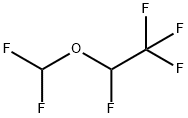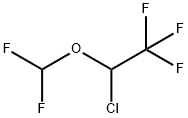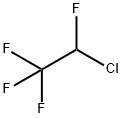Description
Desflurane is a new inhalation anesthetic introduced for induction and maintenance of
general anesthesia in adults. Due to reports of respiratory irritation, desflurane may be
used only for maintenance in children. Although almost structurally identical to
isoflurane, a halogen replacement gives desflurane an improved pharmacokinetic
profile. It is less soluble in blood and tissue and produces a fast onset of action and a
more rapid recovery from anesthesia.
Chemical Properties
Desflurane is a clear, colourless, mobile, heavy liquid. It is similar to isoflurane (CHF2-O-CHCl-CF3) in that both are halogenated compounds of methyl ethane, except that chlorine is replaced with fluorine in the α-ethyl portion. The halogenation of fluorine reduces the solubility of blood and tissues and alters the boiling point, vapor pressure and stability of desflurane, enhancing its molecular stability as well as its resistance to biodegradation and alkaline degradation.
Originator
Anaquest (BOC Healthcare) (U.S.A.)
History
Desflurane was first synthesized by Russel et al U.S. at the 29. of July 1975. The synthesis was started by using floural methyl hemiacetal (CF3CH(OH)OCH3) and converting it to 1,2,2,2- tetraflouroethyl methyl ether (CF3CHFOCH3). Next step was chlorinating two hydrogen atoms of the methyl-group to CF3CHFOCHCl2. This next to last molecule was charged with HF in the presence of antimony pentachloride (SBCL5) to Desflurane. But this way of synthesizing Desfluran was not usable for industrial synthesis, because of the less yield of Desflurane and the expensive educts.
Preparation
Isoflurane and bromine trifluoride were reacted overnight at room temperature to synthesize desflurane in 62% yield.
Definition
ChEBI: Desflurane is an organofluorine compound. It has a role as an inhalation anaesthetic. It is functionally related to a methoxyethane.
brand name
Suprane (Baxter
Healthcare).
Biological Functions
Desflurane (Suprane) shares most of the pharmacological
properties of isoflurane. Desflurane has low tissue
and blood solubility compared with other halogenated
hydrocarbons, and its anesthetic partial pressure is thus
established more rapidly. Recovery is similarly prompt
when the patient is switched to room air or oxygen.
Desflurane’s popularity for outpatient procedures stems
from its rapid onset and prompt elimination from the
body by exhalation. A disadvantage is that desflurane irritates
the respiratory tract; thus, it is not preferred for
induction of anesthesia using an inhalational technique.
However, desflurane may be used to maintain anesthesia
after induction with an alternative IV or inhalational
agent, preserving the advantage of rapid recovery.
Desflurane, like other halogenated hydrocarbon
anesthetics, causes a decrease in blood pressure.The reduced
pressure occurs primarily as a consequence of
decreased vascular resistance, and since cardiac output
is well maintained, tissue perfusion is preserved.
Desflurane stimulates the sympathetic nervous system
and causes abrupt transient tachycardia during induction
or as the concentration of the agent is raised to
meet the patient’s changing needs.
Desflurane causes an increase in the rate of ventilation,
a decrease in tidal volume, and a decrease in
minute volume as inspired concentrations only slightly
exceed 1 MAC. Thus should anesthesiologists require
desflurane to be administered near or above MAC levels,
patients are likely to have marked reductions in
PCO2.
General Description
Desflurane is a nonflammable, colorless, very volatile liquidpackaged in amber-colored vials. The boiling point is22.8°C, and it requires a vaporizer specifically designed fordesflurane. The manufacturer states that the vials can bestored at room temperature. Desflurane has a blood:gas partitioncoefficient of 0.42, an MAC of 7.3% and an oil:gaspartition coefficient of 18.7. The low blood:gas partition coefficientleads to fast induction times and short recoverytimes. Desflurane is not recommended for induction anesthesiain children because of the high incidence of laryngospasms(50%), coughing (72%), breath holding (68%),and increase in secretions (21%). Desflurane can producea dose-dependent decrease in blood pressure and concentrationsexceeding 1 MAC may cause transient increases inheart rate. Desflurane can react with desiccated carbon dioxideabsorbents to produce carbon monoxide that may resultin elevated levels of carboxyhemoglobin.24.
Metabolism
Desflurane is not metabolized to any great extent and, therefore, has not been associated with hepatotoxicity or nephrotoxicity. Metabolites, mostly trifluoroacetate, account for less than 0.02% of the administered dose. Whereas desflurane can react with soda lime or Baralyme to form carbon monoxide, no reports of adverse outcomes in patients have appeared.




